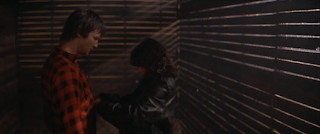Bladerunner 2049 (2017)
Directed by Denis Villeneuve
Written by Hampton Fancher and Michael Green
***SPOILERS***
I have been anticipating this movie for a long time. I have mixed feelings about the first film Bladerunner (1982) because I love the original book so much "Do Androids dream of electric sheep" by Philip K. Dick and feel it didn't do it justice.
However this film is beautiful in execution. It is stylistically beautiful, aside from the unashamed product placement, but this was a feature in the original.
The plot was somewhat basic but the set design and lighting are sensational and conjured up reminiscence of the 1982 version. This film served as mostly remake and the storyline was a bit obvious and straightforward.
What I found most interesting in the film was K/ Joe's journey about himself and the stigma he has about being a "skinner"/ "skinjob". It explores how Joe loves his wife who turns out to be merely a pleasure model hologram. Like a shadow on Plato's cave. A simulacra, a simulation of a simulation.
I found the sex scene (off camera) was totally unnecessary and made no sense that Joe should have only had 48 hours to be on the run and he stops to have sex with a prostitute. It was purely so she could plant something on him, it otherwise didn't make sense.
The pleasure model, his wife fits the "Born Sexy Yesturday trope"
She is naive and doesn't really think for herself, is merely there for the main character's pleasure and development. I guess there were elements that he made her into a more "real" human. And that he loved her, because he modified her to his own desires to have a wife. She is frequently sexually objectified.
The set design and costuming are true to the original and maintain that stylised idustrialised post-apocalyptic vibe. One thing I noticed that we didn't really see in the original is daylight, in the original it was always dark and raining for the most part. The colour use and lighting were also great. Lots of blues and yellows. There is a lot of use of contrast and silhouettes which mirror the original film although the original was a bit softer rather than these start outlines, there was more gradation.
I was a bit disappointed in the end "battle" sequence. Saving Deckard and sacrificing himself. The fight between Love and Joe wasn't that interesting and quite predictable.
I was also disappointed that Harrison Ford as old Deckard doesn't show up until the 3rd act. And they simply explain away the 4 year deterioration of replicants models which at first makes you open to the idea the Deckard could or could not be a replicant. In my opinion it is obvious from the final cut version with the last scene of Deckard and Rachel and the origami that Deckard IS in fact a replicant and should be dead by 2049. However it was a small detail.
I found the whole baby replicant thing really interesting and would have like that explored more and what happened to Rachel, there was only a short amount of exposition from Deckard about it. I liked the twist that Joe wasn't actually the child and I didn't predict that the girl in the bubble/ chamber was the daughter. I'm glad Joe wasn't because that was way too obvious. I didn't even guess that it would be her, but I guess the clue was when she cried viewing "his" memory and she was really remembering her own memory.
Overall I really enjoyed, the execution and style was amazing and the plot was better than expected.



























































